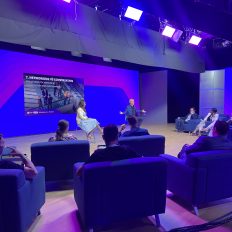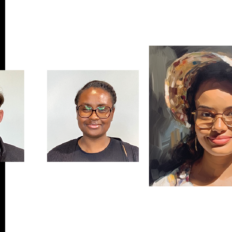Virtual reality meetings. You probably heard of the idea years ago, and now they’re back? You may have seen Mark Zuckerberg announce Facebook’s next big bet Horizon Workrooms, virtual reality meeting spaces. He calls it the “metaverse.”
Naturally, the Cramer team started asking, is this a preview of where events and brand experiences are heading? To help us think through the larger impact of this announcement, we asked a few of our team members at the forefront of strategy and production to weigh in. Here are their reactions:
1. What role do you think VR will play in the future of events and experiential marketing?
Rachael Truscott | VP Program Strategy & Communication
Firstly, I believe that in-person events will only increase in demand and value. While in-person will always remain my personal first choice, I anticipate exponential growth in the creation and use of VR experiences. In short, I believe we are on the ground floor of what will be an incredible innovation in technology and creativity related to VR events.
Angel Micarelli | SVP, Strategy & Content
What’s so interesting to me is that there was a lot of talk about virtual worlds in the workplace about ten years ago. It just never took off. Now, after our collective virtual experience during the pandemic, I think it has legs.
Mark Wilson | Executive Creative Director
First, I love new technology. But this Facebook entry in the area already looks old, dated, and tired. I think this iteration of VR is doomed to fail for two simple reasons:
- Minimal adoption of the Oculus Quest 2 — Facebook’s virtual reality headset. Do you know anyone that has one? Or that uses it more than twice a week for longer than 30 minutes at a time? Neither do I.
- What makes it fun requires time and effort before a show or program. That creates new barriers to entry. Maybe I have to download software, and I know I must build an avatar. I have to figure out the layout of the virtual/physical space and try to find and communicate with people I know in new modalities. These things take time. Do my employees, attendees, friends have that time? Will they enjoy the experience? Is it worth it to them?
Right now, most of the VR experiences/platforms shared experience spaces out there succeed as novelties but fail as legitimately rewarding experiences. The hope and hype you hear is optimistic hyperbole. Sure, we can all put it into our trends presentations and talk about what will be but right now, file it under NADA. Or maybe TBD. This is based on firsthand experience – here at Cramer, we have tried many and pitched many of these environments (and I don’t want to disparage any single platform here). I’ve gone to events, meetings, concerts, and wrap parties. But for the most part, the folks paying the bills – our clients – don’t want to do it. They’re intrigued, but it stops there. With all that said, I would encourage everyone to dive in and try it. I do think it’s fun. I just don’t see VR in its current state as a satisfying and fluid experience for events.
2. What are you watching for as companies explore solutions like “Horizon Workrooms,” to inform your opinions on event strategies and adopt new technologies for events?
Angel: Back in 2011, Microsoft did a study on users’ comfort with avatars. It showed people are open to the idea of using avatars for workplace communication, but the choice of the avatar can significantly impact people’s comfort. Going forward, it will be interesting to see if we gravitate to more realistic digital twins or “cartoons.”
Rachael: We are all familiar with the unique benefits of virtual events – and we will not lose sight of the known qualitative measures (i.e., getting access to a thought leader that could not otherwise participate) and the ever-growing set of quantitative data (time spent in space, capturing comments, etc.). In addition to these, I think VR will bring a whole new dimension to benchmarking and measuring success. For example, the choices that attendees make when building their avatars, (monitor enough of these choices, and marketers have a library of virtual personas). I will also be on the lookout for new ways these VR spaces encourage making peer-to-peer connections, workshops, and problem solve.
Mark: What to watch for? An evolution in technology that makes it feel like magic. When the experience feels borderless and fluid. When I can pick it up and do it without instruction. When I can afford to purchase a headset, hardware, and software for my entire audience. The wide adoption of elegant high functioning technology is the big barrier to success. Will it change? Absolutely. But when? Not likely to be soon.
3. What technology are you most looking forward to implementing into event strategies of the future? Or what technology do you want to see created to improve experiential marketing?
Angel: Its application in networking is the most intriguing. But frictionless technology will be the key to bringing the metaverse into events. We need to make it intuitive and easy.
Rachael: Even more important than new technology is the way that tech companies treat captured information. There is a need for truth, trust, and transparency for the attendee’s digital information capture. Users need more control over their own data and when we are going to, for example, an exclusive event, we expect confidentiality (while we simultaneously believe that privacy is dead). If companies like Facebook can’t build that trust and transparency, executives and/or highly regulated industries are not going to participate, and their thought leadership and contributions are essential to progress.
In terms of the actual tech…I am interested in technologies that re-imagine our real-world experience. Specifically, I am watching what’s happening with 3D, 7D, and hologram technology. We’ve all seen Tony Stark manipulate virtual diagrams hanging in mid-air with no need for a “screen”. Imagine a VR Fishbowl style Think Tank where I can be (in reality) standing in my living room while (virtually) standing in the fishbowl with my ideas manipulating graphics in real-time. Further imagine some of my peers are physically together in a room, while others are miles away.
Technology is reshaping our human experience, as individuals and collectively. While we are talking about events today, the impact new technologies are having on our Agency and our client’s businesses as a whole – it’s immeasurable and so exciting! Peek at the incredible power of multidimensional technologies is having on Advertising. You’ll never look at a billboard the same way again.
Mark: Cramer has spent the last 18 months developing a highly effective new modality to how we plan and execute events. And, shocker, it places humans and human connection at the center! Or more accurately within a 3-dimensional experience grid that facilitates simultaneous presenter/content options right alongside multiple audience viewing locations/options and, the onsite and virtual production infrastructure to get it done.
In some ways, it feels like a perfectly logical evolution, but you must see the big picture and understand the pieces you’re looking at… how can we take the current set of ingredients of virtual and broadcast platforms, streaming technologies, venue production gear, and create what’s next?
We live in a world where we can have a presenter on stage or at home, where two panelists from one location can be combined with two from another. We can bring in entertainment from anywhere or shoot them on a venue stage. The audience can see them, and they can see, and talk to each other in real-time. No small feat and critical to cohesive viewing and presenting experience.
We can now produce programs using this matrix architecture with the same level of reliability and security that we’ve always done in venues and offer clients basically any combination of the above that makes sense given their situation.
Whether you’re in our broadcast studio, a ballroom, a restaurant, or your living room, we can create and produce seamless and professional event experiences that just feel easy and elegant. We bring audiences together with the way they want to be together. Meeting them where they’re at and making it work. We can make it happen. We can scale it. And we can do it today. It seems like we have a variety of opinions to sort through here, but one thing remains clear – there is a lot of opportunity for technology to enable seamless and immersive experiences for audiences everywhere. Will the “metaverse,” be the next big thing in events or something else? That remains to be seen, but we are keeping our eyes open for new possibilities and new ways of thinking.



